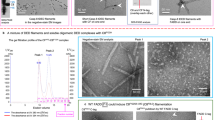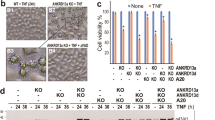Abstract
Fas is the death receptor, transducing cell death signaling upon stimulation by Fas ligand. During Fas-initiated cell death signaling, the formation of Fas-death inducing signaling complex (Fas-DISC) is the first step. Here we have identified a new component of Fas-DISC which we call 'small-accelerator for death signaling' (SADS). SADS cDNA encodes a 150 amino acid polypeptide (Mr = 16,700). During Fas-mediated cell death, SADS enhances the interaction of Fas-death domain-interactive factors (FADD) and procaspase-8, and deletion mutant analysis has identified FADD- and caspase-8-interactive domains in SADS. Inhibition or removal of SADS delays Fas-mediated cell death. In addition, we demonstrate the deletion or mutation of SADS in patients with colon carcinoma and that exogenous SADS expression in human colon carcinoma SW480 cells that lack SADS leads to re-acquisition of Fas-mediated cell death. Here, we propose that SADS is one of the cell death-associated factors and enhances Fas-DISC formation, especially FADD and procaspase-8 recruitment.
This is a preview of subscription content, access via your institution
Access options
Subscribe to this journal
Receive 12 print issues and online access
$209.00 per year
only $17.42 per issue
Buy this article
- Purchase on Springer Link
- Instant access to full article PDF
Prices may be subject to local taxes which are calculated during checkout






Similar content being viewed by others
References
Wyllie, A.H., Kerr, J.F.R. & Currie, A.R. Cell death: The significance of apoptosis Int. Rev. Cytol. 68, 251–306 (1980).
Nagata, S. Apoptosis by death factor. Cell 88, 355–365 (1997).
Nagata, S. & Golstein, P. The Fas death factor. Science 267, 1449–1456 (1995).
Yonehara, S., Ishii, A. & Yonehara, M. A cell killing monoclonal antibody (anti-Fas) to a cell surface antigen co-downregulated with the receptor of tumor necrosis factor. J. Exp. Med. 169, 1747–1756 (1989).
Alnemri, E.S. et al. Human ICE/CED-3 protease nomenclature. Cell 87, 171 (1996).
Enari, M., Talanian, R.V., Wong, W.W. & Nagata, S. Sequential activation of ICE-like and CPP32-like proteases during Fas-mediated apoptosis. Nature 380, 723–726 (1996).
Fernandes-Alnemri, T., Litwack, G. & Alnemri, E.S. CPP32, a novel human apoptotic protein with homology to Caenorhabditis elegans cell death protein Ced-3 and mammalian interleukin-1β-converting enzyme. J. Biol. Chem. 267, 30761–30764 (1994).
Boldin, M.P., Goncharov, T.M., Golstev, Y.V. & Wallach, D. Involvement of MACH, a novel MORT-1/FADD-interacting protease, in Fas/APO-1 and TNF receptor-induced cell death. Cell 85, 803–815 (1996).
Itoh, N. et al. The polypeptide encoded by the cDNA for human cell surface antigen Fas can mediate apoptosis. Cell 66, 233–243 (1991).
Watanabe-Fukunaga, R., Brannan, C.I., Copeland, N.G., Jenkins, N.A. & Nagata, S. Lymphoproliferation disorder in mice explained by defects in Fas antigen that mediates apoptosis. Nature 356, 314–317 (1992).
Chinnaiyan, A.M., O'Rourke, K., Tewari, M. & Dixit, V.M. FADD, a novel death domain-containing protein, interacts with the death domain of Fas and initiates apoptosis. Cell 81, 505–512 (1995).
Kischkel, F.C. et al. Cytotoxicity-dependent APO-1 (Fas/CD95)-associated proteins form a death-inducing signaling complex (DISC) with the receptor. EMBO J. 14, 5579–5588 (1995).
Thornberry, N.A. et al. A combinatorial approach defines specifities of members of the caspase family and granzyme B: Functional relationships established for key mediators of apoptosis. J. Biol. Chem. 272, 17907–17911 (1997).
Tewari, M. et al. Yama/CPP32β, a mammalian homolog of CED-3, is a CrmA-inhibitable protease that cleaves the death substrate poly(ADP-ribose) polymerase. Cell 81, 801–809 (1995).
Lazebnik, Y.A. et al. Studies of lamin proteinase reveal multiple parallel biochemical pathways during apoptosis. J. Biol. Chem. 92, 9042–9046 (1995).
Sahara, S. et al. Acinus is a caspase-3-activated protein required for apoptotic chromatin condensation. Nature 401, 168–173 (1999).
Liu, X., Zou, H., Slaughter, C. & Wang, X. DFF, a heterodimeric protein that functions downstream of caspase-3 to trigger DNA fragmentation during apoptosis. Cell 89, 175–184 (1997).
Shiraki, K., Tsuji, N., Shioda, T., Isselbacher, K.J. & Takahashi, H. Expression of Fas ligand in liver metastases of human colonic adenocarcinomas. Pro. Natl. Acad. Sci. USA 94, 6420–6425 (1997).
Muzio, M. et al. FLICE, a novel FADD-homologous ICE/CED-3-like protease, is recruited to the CD95 (Fas/APO-1) death-inducing signaling complex. Cell 85, 817–827 (1996).
Imai, Y. et al. The CED-4-homologous protein FLASH is involved in Fas-mediated activation of caspase 8 during apoptosis. Nature 398, 777–785 (1999).
Suzuki, A., Araki, T., Miura, M. & Tsutomi, Y. Functional absence of FADD in PLC/PRF/5 cells: Possible involvement in the transformation to hepatoma in HBV-infected hepatocyte. Proc. Soc. Exp. Biol. Med. 221, 72–79 (1999).
Sprick, M. et al. FADD/MORT1 and caspase-8 are recruited to TRAIL receptor 1 and 2 are essential for apoptosis mediated by TRAIL receptor 2. Immunity 12, 599–609 (2000).
Kischkel, F.C. et al. Apo2L/TRAIL-dependent recuitment of endogenous FADD and caspase-8 to death receptors 4 and 5. Immunity 12, 611–620 (2000).
Scaffidi, C. et al. Two CD95 (APO-1/Fas) signaling pathways. EMBO J. 17, 1675–1687 (1998).
Itoh, N. & Nagata, S. A novel protein domain required for apoptosis; Mutational analysis of human Fas. J. Biol. Chem. 268, 10932–10937 (1993).
Hasegawa, J. et al. Involvement of CPP32/Yama(-like) proteases in Fas-mediated apoptosis. Cancer Res. 56, 1713–1718 (1996).
Acknowledgements
We thank S. Sugano for the KATO8558 cDNA clone in pME18S-FL; Y. Tsujimoto for D98AH2 cell line; S. Yonehara for human caspase-8 expression vector; M. Miura and Y. Gotoh for discussions; and K. Akahane, M. Aonuma and Y. Kita for technical suggestions.
Author information
Authors and Affiliations
Corresponding author
Rights and permissions
About this article
Cite this article
Suzuki, A., Obata, S., Hayashida, M. et al. SADS: A new component of Fas-DISC is the accelerator for cell death signaling and is downregulated in patients with colon carcinoma. Nat Med 7, 88–93 (2001). https://doi.org/10.1038/83401
Received:
Accepted:
Issue Date:
DOI: https://doi.org/10.1038/83401
This article is cited by
-
Overcoming chemotherapy drug resistance by targeting inhibitors of apoptosis proteins (IAPs)
Apoptosis (2017)
-
A SADS defect in tumor cells provides optimism
Nature Medicine (2001)
-
Inhibition of histone deacetylase activity enhances Fas receptor-mediated apoptosis in leukemic lymphoblasts
Cell Death & Differentiation (2001)
-
How melanoma cells evade trail-induced apoptosis
Nature Reviews Cancer (2001)



